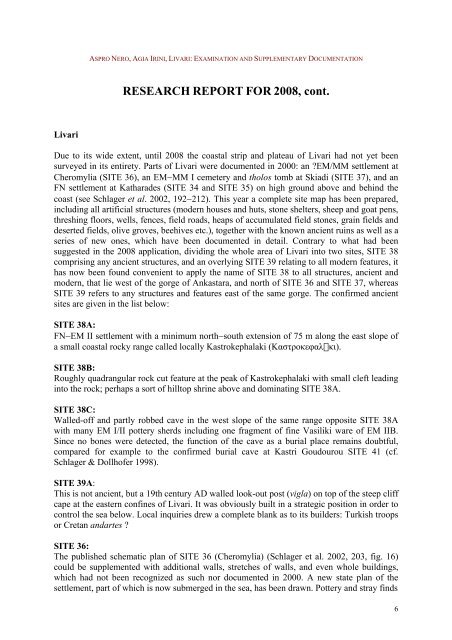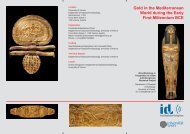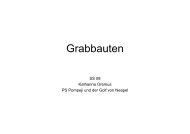RESEARCH REPORT FOR 2008, cont.
RESEARCH REPORT FOR 2008, cont.
RESEARCH REPORT FOR 2008, cont.
Create successful ePaper yourself
Turn your PDF publications into a flip-book with our unique Google optimized e-Paper software.
Livari<br />
ASPRO NERO, AGIA IRINI, LIVARI: EXAMINATION AND SUPPLEMENTARY DOCUMENTATION<br />
<strong>RESEARCH</strong> <strong>REPORT</strong> <strong>FOR</strong> <strong>2008</strong>, <strong>cont</strong>.<br />
Due to its wide extent, until <strong>2008</strong> the coastal strip and plateau of Livari had not yet been<br />
surveyed in its entirety. Parts of Livari were documented in 2000: an ?EM/MM settlement at<br />
Cheromylia (SITE 36), an EM−MM I cemetery and tholos tomb at Skiadi (SITE 37), and an<br />
FN settlement at Katharades (SITE 34 and SITE 35) on high ground above and behind the<br />
coast (see Schlager et al. 2002, 192−212). This year a complete site map has been prepared,<br />
including all artificial structures (modern houses and huts, stone shelters, sheep and goat pens,<br />
threshing floors, wells, fences, field roads, heaps of accumulated field stones, grain fields and<br />
deserted fields, olive groves, beehives etc.), together with the known ancient ruins as well as a<br />
series of new ones, which have been documented in detail. Contrary to what had been<br />
suggested in the <strong>2008</strong> application, dividing the whole area of Livari into two sites, SITE 38<br />
comprising any ancient structures, and an overlying SITE 39 relating to all modern features, it<br />
has now been found convenient to apply the name of SITE 38 to all structures, ancient and<br />
modern, that lie west of the gorge of Ankastara, and north of SITE 36 and SITE 37, whereas<br />
SITE 39 refers to any structures and features east of the same gorge. The confirmed ancient<br />
sites are given in the list below:<br />
SITE 38A:<br />
FN−EM II settlement with a minimum north−south extension of 75 m along the east slope of<br />
a small coastal rocky range called locally Kastrokephalaki (Καστροκεφαλ κι).<br />
SITE 38B:<br />
Roughly quadrangular rock cut feature at the peak of Kastrokephalaki with small cleft leading<br />
into the rock; perhaps a sort of hilltop shrine above and dominating SITE 38A.<br />
SITE 38C:<br />
Walled-off and partly robbed cave in the west slope of the same range opposite SITE 38A<br />
with many EM I/II pottery sherds including one fragment of fine Vasiliki ware of EM IIB.<br />
Since no bones were detected, the function of the cave as a burial place remains doubtful,<br />
compared for example to the confirmed burial cave at Kastri Goudourou SITE 41 (cf.<br />
Schlager & Dollhofer 1998).<br />
SITE 39A:<br />
This is not ancient, but a 19th century AD walled look-out post (vigla) on top of the steep cliff<br />
cape at the eastern confines of Livari. It was obviously built in a strategic position in order to<br />
<strong>cont</strong>rol the sea below. Local inquiries drew a complete blank as to its builders: Turkish troops<br />
or Cretan andartes ?<br />
SITE 36:<br />
The published schematic plan of SITE 36 (Cheromylia) (Schlager et al. 2002, 203, fig. 16)<br />
could be supplemented with additional walls, stretches of walls, and even whole buildings,<br />
which had not been recognized as such nor documented in 2000. A new state plan of the<br />
settlement, part of which is now submerged in the sea, has been drawn. Pottery and stray finds<br />
6







